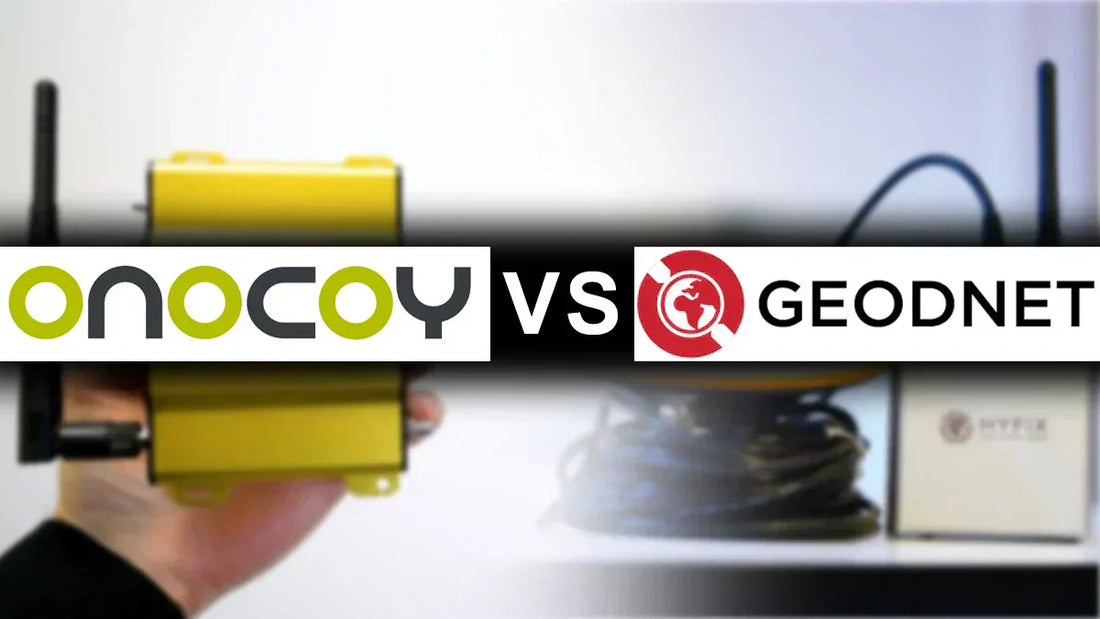
GEODNET vs. Onocoy: Which DePIN GNSS Project Should You Mine With in 2025?
Share
Hey everyone, Nordic Crypto here. If you’ve been following my DePIN journey since 2020, you know I’m all about diving into the best DePIN projects that let us earn passive income with mining like devices. Today, we’re tackling two heavy hitters in the decentralized GNSS (Global Navigation Satellite System) space: GEODNET and Onocoy. Both are building networks for high-precision location services, but they’ve got different vibes, approaches, and opportunities. I’ve been running miners for both, and I’m stoked to break down their differences, similarities, and why I think there’s room for both in your mining setup. Let’s dive in!
What Are GEODNET and Onocoy?
Before we get into the comparison, here’s a quick 20-second recap of each project.
GEODNET (Global Earth Observation Decentralized Network), kicked off in 2021, is a blockchain-powered RTK (Real-Time Kinematics) network that delivers centimeter-level GPS accuracy. It’s got over 18,000 active satellite miners across 140 countries, making it the largest RTK network globally, even surpassing Web2 giants like Trimble. You set up a GEODNET miner (a GNSS reference station) on your roof, contribute correction data, and earn GEOD tokens. It’s a proven player with partnerships like Boson Motors for autonomous farming trucks and Wingbits for flight tracking. GEODNET’s market cap is around $56.92M, with GEOD tokens trading at about $0.18 as of June 2025.
Onocoy, also started in 2021 in Switzerland, is a community-driven DePIN project on the Solana blockchain, focused on making high-precision GNSS data accessible everywhere. With ~5,200 stations worldwide, it’s smaller but growing fast. Onocoy’s RTK tech also corrects satellite signals for applications like drones, autonomous vehicles, and agriculture. You can set up a miner to provide data and earn BONO tokens now, which will convert to ONO tokens after their TGE (Token Generation Event) in Q3 2025. Onocoy’s raised $4.2M, mostly from research-based Web2 and Web3 investors, and has a pay-per-use model for their positioning service that’s super affordable (e.g., $0.15/hour).
Both projects are tackling the $250B+ GNSS market for high-precision services. I think there's definitely plenty of room for multiple players, so I’m betting on both. But let’s break down how they stack up.

GEODNET vs. Onocoy: The Big Differences
Here’s where things get interesting. Both projects aim for centimeter-level accuracy, but their approaches, hardware, business models, and vibes are different. Let’s compare them based on what I’ve learned from researching reach project and running their miners.
1. Network Size and Maturity
GEODNET: This is the bigger project currently. With over 18,000 miners in 4,000 cities, GEODNET’s network is massive, growing 219% year-over-year in 2024. It’s already generating $4M in annualized revenue and has major partnerships, like Propeller for construction mapping and Boson Motors for autonomous farming. GEODNET’s been around long enough to present to the US Congress, showing it’s doing serious business. If you want a stable, established project, GEODNET’s your pick.
Onocoy: With ~5,200 stations (up from 3,700 earlier in 2025), Onocoy’s smaller but fast growing. It’s only been selling its positioning services since August 2024. Onocoy’s focus is on rapid, community-driven growth, especially in undeserved areas like rural regions or developing countries. It’s newer, so there’s more upside potential if you’re an early mover.
My Take: GEODNET’s size gives it an edge for revenue and market recognition right now, but Onocoy’s early stage means bigger potential rewards for those stacking BONO tokens before the ONO TGE. I’m running both because GEODNET seems like a safe bet, and Onocoy’s a high-upside play.

2. Hardware and Accessibility
GEODNET: You need a specific GEODNET miner, like the Hyfix MobileCM, which costs around $625. It’s a plug-and-play setup, but you’re locked into their hardware, and it’s pricier. You mount the antenna on your roof with a clear sky view, and you’re good to go. I’ve had mine running for years without touching it, so it's super low maintenance. But you can’t use your own gear, and accessing your own RTK data requires going through GEODNET’s network, which some folks find restrictive.
Onocoy: This is where Onocoy shines. Their Bring Your Own Device (BYOD) model lets you use affordable hardware like u-blox or Septentrio receivers, or ready bundles like Onolink or NTRIP-X. And you can even build a DIY station using a Raspberry Pi and UM980 for budget-friendly precision. Onocoy’s open hardware approach makes it accessible, especially in places like Africa where cost matters. Plus, you can stream RTK data directly for your own use without going through their network.
My Take: Onocoy’s BYOD model is a game-changer for affordability and flexibility. GEODNET’s hardware is reliable but less open, leaving the aspect of scaling in Onocoy's favor. If you’re on a budget or love tinkering with DIY setups, Onocoy’s your jam. I’ve set up an Onolink miner and love how easy it is to optimize with their sky visibility map, see the onocoy setup here.

3. Business Model and Cost for Users
GEODNET: GEODNET uses a subscription model, charging users ~$400/year for access to their RTK network. It’s great for businesses but can be steep for smaller users or those in less affluent areas. The model’s predictable revenue stream has helped GEODNET scale, but it’s less flexible.
Onocoy: Onocoy’s pay-per-use model is a breath of fresh air. You pay only for the data you need which is around $0.15/hour or $5 for 33 hours. This is way cheaper than competitors’ yearly fees, making it ideal for developers, small businesses, or hobbyists. They’ve also got two services: “Permanent” for specific stations (e.g., scientific monitoring) and “Nearest” for dynamic applications like drones or vehicles.
My Take: Onocoy’s pay-per-use approach is perfect for mass adoption, especially in underserved regions. GEODNET’s subscription model suits bigger players but limits accessibility. If you’re betting on global reach, Onocoy’s model could drive faster growth.
4. Tokenomics and Mining Rewards
GEODNET: GEOD tokens are live, trading at ~$0.18 with a $56.92M market cap and $179.45M fully diluted valuation. The max supply is 1B tokens, with 317M circulating. Miners earn GEOD based on data quality and location, in a hex-based reward system. Each hex is 20km from side to side, and several miners within a hex share the daily GEOD token rewards. In Q4 2024, GEOD token burns hit an all-time high (up 463% in USD terms), showing strong demand. You can cash out GEOD now, which is great for steady income.
Onocoy: Onocoy’s in beta, so miners earn BONO tokens, which currently have a value of $0.17 per BONO token. These BONO tokens will however convert to ONO tokens after the TGE in summer 2025. There's rumors that the conversion ratio from BONO to ONO might be higher than 1:1. The ONO max supply is 810M, with 40% allocated to miners/community, 22% to ecosystem, 24% to investors, 10% to the team, and 4% for market making. ONO tokens will be used to swap for data credits, with some burned and some redistributed to miners. Rewards depend on data quality and location (three stations per 15km radius), and Onocoy’s explorer tools (like the reward estimator, sky visibility map and split reward sharing) help you maximize earnings. There’s also a 5x reward boost in South Korea, Japan, Malaysia, Taiwan, Thailand, and Singapore until September 2025.
My Take: GEODNET’s live trading tokens with large liquidity mean you can earn real money now, but Onocoy’s beta stage is the time to stack BONO tokens for potentially huge gains post-TGE. I’m mining both to hedge my bets, so GEOD for stability, BONO for upside. Onocoy’s early mover boost and 5x campaign in Asia are tempting if you’re in those regions!

5. Leadership and Credibility
GEODNET: Led by Mike Horton, a GPS industry vet with over 20 years of experience, GEODNET’s team includes experts from Anello Photonics and Crossbow Technology. GEODNET have raised $12M, including $2M from Animoca Brands and ParaFi Capital, and have a non-profit foundation in Singapore driving global adoption. Their track record and partnerships is beyond impressive..
Onocoy: Co-founded by Daniel Ammann, a GNSS legend who co-founded u-blox (powering GPS in 80% of cars) and won the GPS World Leadership Award in 2016, so Onocoy’s got a rockstar leader. They’ve raised $4.2M, with $2.5M from non-dilutive grants and SAFTs, including $940K from Web3 VC Smart Island Capital. As a non-profit association, Onocoy’s mission-driven focus is on accessibility which aligns with its community. Learn more about Onocoy's leadership here.
My Take: Both have top-tier founders, but Ammann’s u-blox legacy and Onocoy’s research-based funding give it a unique edge in innovation. GEODNET’s Horton and bigger funding make it a safer bet for enterprise adoption currently. Honestly, you can’t go wrong with either team.
Can You Dual-Mine GEODNET and Onocoy?
Here’s a cool info segment: you can dual-mine GEODNET and Onocoy with one antenna using a splitter and extra You’ll need a power-blocking GPS splitter to connect your antenna to both miners, but it’s a sweet way to maximize earnings from one roof setup. Here's a video on how to dual mine and connect multiple devices using a splitter. Disclaimer: Dual-mining isn’t officially recommended by GEODNET, and if your GEODNET miner gets damaged, you might be out of luck. Proceed at your own risk.

Which Should You Choose?
So, GEODNET or Onocoy? Here’s my take, based on years of mining.
Pick GEODNET if: You want a stable, more established project you can sell right now. It’s perfect if you’ve got the budget for their miner (~$625) and want reliable income from a massive network with enterprise partnerships. GEODNET’s currently a safe bet for steady passive income.
Pick Onocoy if: You’re an early mover chasing high-upside potential. With cheaper, open hardware (like Onolink or DIY setups) and a pay-per-use model, Onocoy’s built for global adoption, especially in underserved areas. Stacking BONO tokens now could pay off big after the ONO TGE in summer 2025, especially with the 5x reward boost in Asia.
Pick Both if: Like me, you see the $250B+ GNSS market as big enough for multiple winners. Dual-mining lets you earn GEOD and BONO from one antenna, hedging your bets on stability and growth. It’s a low-power setup you can forget about once it’s running.
Final Thoughts
GEODNET and Onocoy are both killer DePIN projects revolutionizing high-precision GNSS. GEODNET’s the market leader with a massive network, live tokens, and enterprise clout. Onocoy’s currently the underdog with a community-driven, accessible approach and huge upside potential. I’m bullish on both because the demand for centimeter-level positioning is skyrocketing, for areas like autonomous vehicles, drones, and precision farming. Whether you go with GEODNET’s stability, Onocoy’s growth potential, or dual-mine, you’re getting in on a game-changing industry. If you want to learn all there is about onocoy, check out our Onocoy Miner hub.
What do you think, GEODNET, Onocoy, or both? Have you set up a miner yet? Drop a comment below!
Disclaimer: This isn’t financial or investment advice but just my thoughts based on running miners and researching these projects. Always DYOR (do your own research) before investing or setting up hardware. Crypto and DePIN projects carry risks, and past performance doesn’t guarantee future results.

